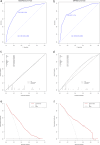Prediction of microvascular invasion in hepatocellular carcinoma using a preoperative serum C-reactive protein-based nomogram
- PMID: 39748118
- PMCID: PMC11696813
- DOI: 10.1038/s41598-024-84835-w
Prediction of microvascular invasion in hepatocellular carcinoma using a preoperative serum C-reactive protein-based nomogram
Abstract
Microvascular invasion (MVI) diagnosis relies on postoperative pathological examinations, underscoring the urgent need for a novel diagnostic method. C-Reactive Protein (CRP), has shown significant relevance to hepatocellular carcinoma (HCC) prognosis. This study aims to explore the relationship between preoperative serum CRP levels and microvascular invasion in hepatocellular carcinoma and develop a nomogram model for predicting MVI. Patients were categorized into MVI-positive and MVI-negative groups for analysis. Serum CRP levels were compared between the two groups. And then use LASSO regression to screen variables and build a nomogram. CRP levels showed significant differences between the MVI-positive and MVI-negative groups. Multivariable logistic regression analysis identified CRP (OR = 4.85, P < 0.001), lnAFP (OR = 3.11, P < 0.001), WBC count (OR = 2.73, P = 0.003), and tumor diameter (OR = 2.38, P = 0.01) as independent predictors of MVI. A nomogram based on these variables showed good predictive performance in both the training and validation cohorts with dual validation. The clinical prediction nomogram model, which includes serum CRP levels, WBC count, tumor diameter, and serum AFP levels, showed good performance in predicting MVI in both the training and validation cohorts.
Keywords: C-Reactive protein; Clinical prediction model; Hepatocellular carcinoma; Microvascular invasion.
© 2024. The Author(s).
Conflict of interest statement
Declarations. Competing interests: The authors declare no competing interests. Institutional review board statement: This research complied with all principles and regulations outlined in the Declaration of Helsinki and was approved by the ethics review committee of scientific research projects of the first affiliated hospital of Zhengzhou university (2024-KY-0282-002). Informed consent: This study was a retrospective study, and the hospital ethics committee waived the patient’s informed consent.
Figures





Similar articles
-
A nomogram to predict microvascular invasion in early hepatocellular carcinoma.J Cancer Res Ther. 2021 Jul;17(3):652-657. doi: 10.4103/jcrt.JCRT_1714_20. J Cancer Res Ther. 2021. PMID: 34269295
-
MRI-based clinical-radiomics nomogram model for predicting microvascular invasion in hepatocellular carcinoma.Med Phys. 2024 Jul;51(7):4673-4686. doi: 10.1002/mp.17087. Epub 2024 Apr 20. Med Phys. 2024. PMID: 38642400
-
Nomogram to Assist in Surgical Plan for Hepatocellular Carcinoma: a Prediction Model for Microvascular Invasion.J Gastrointest Surg. 2019 Dec;23(12):2372-2382. doi: 10.1007/s11605-019-04140-0. Epub 2019 Feb 28. J Gastrointest Surg. 2019. PMID: 30820799
-
Significance of presence of microvascular invasion in specimens obtained after surgical treatment of hepatocellular carcinoma.J Gastroenterol Hepatol. 2018 Feb;33(2):347-354. doi: 10.1111/jgh.13843. J Gastroenterol Hepatol. 2018. PMID: 28589639 Review.
-
Advances in multi-omics studies of microvascular invasion in hepatocellular carcinoma.Eur J Med Res. 2025 Mar 13;30(1):165. doi: 10.1186/s40001-025-02421-w. Eur J Med Res. 2025. PMID: 40075448 Free PMC article. Review.
References
-
- Sung, H. et al. Global Cancer statistics 2020: GLOBOCAN estimates of incidence and mortality worldwide for 36 cancers in 185 countries. CA Cancer J. Clin.71, 209–249 (2021). - PubMed
-
- Rodríguez-Perálvarez, M. et al. A systematic review of microvascular invasion in hepatocellular carcinoma: diagnostic and prognostic variability. Ann. Surg. Oncol.20, 325–339 (2013). - PubMed
-
- Lim, K. C. et al. Microvascular invasion is a better predictor of tumor recurrence and overall survival following surgical resection for hepatocellular carcinoma compared to the Milan criteria. Ann. Surg.254, 108–113 (2011). - PubMed
-
- Liu, Y. et al. Comparative analysis of anatomic and non-anatomic hepatectomy for single small hepatocellular carcinoma with microvascular invasion. Zhonghua Yi Xue Za Zhi98, 1937–1940 (2018). - PubMed
MeSH terms
Substances
LinkOut - more resources
Full Text Sources
Medical
Research Materials
Miscellaneous

